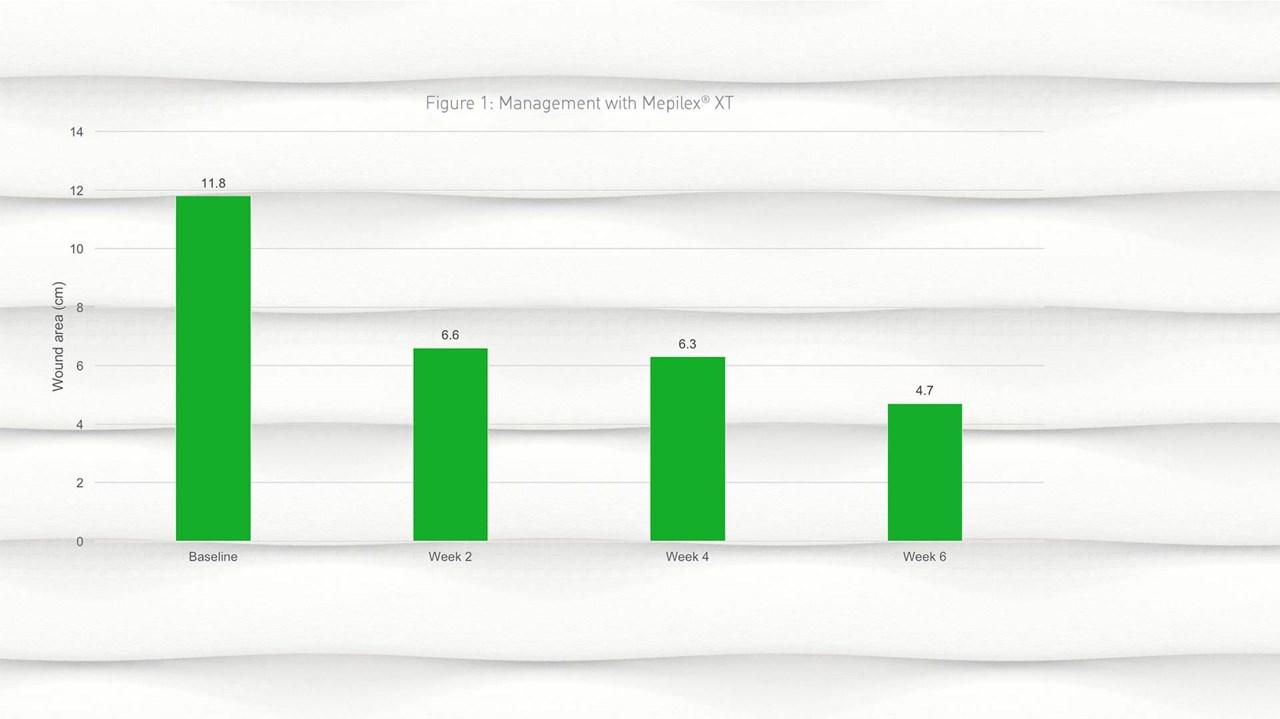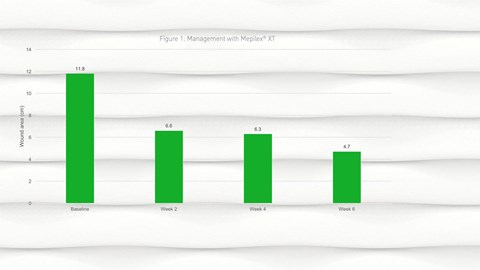Mepilex XT in practice
Various wounds, including venous leg ulcers, responded well to Mepilex® XT. The dressing effectively managed different types of wound exudate in an eight-month study.

Mepilex XT in practice: results of a study in German specialist wound care centers
Lantin A, Diegel C, Scheske J, Schmitt C, Brönner A, Jodl H. Wounds International 2015; 6(4):18-22
- Effective exudate management has been shown to contribute to a reduction in time to wound healing, a reduction in skin damage and risk of infection, and an improvement in patient quality of life and healthcare efficiency.
- It is important that clinicians find a balance between the beneficial and damaging effects of wound exudate; this will help to achieve moist wound healing, while minimizing the risk of moisture-related damage to the wound and periwound skin.
- Focus should be on the nature of wound exudate as well as exudate volume. The clinical and economic challenges posed by different exudate types should be considered when developing an exudate management plan.
- Mepilex XT incorporates exudate management channels designed to draw both low and high viscosity exudate away from the wound bed, helping to protect the wound and peri-wound area from moisture-related damage.
Aims
To evaluate the performance of Mepilex XT in clinical practice, when used as part of the wound management regimen in a variety of wound types.
Methods
- Registry study, conducted across 10 specialized wound care centers in Germany; all of the centers work with the same standard treatment path and use a digital wound documentation system.
- Mepilex XT was used across all 10 wound care centres over an 8-month period.
- A number of different wound types were included in the study, including arterial/mixed/venous ulcers, traumatic wounds, diabetic/neuropathic ulcers, decubitus ulcers and neoplastic wounds. These wounds were located in a variety of anatomical locations.
- For each wound managed with Mepilex XT, data captured at each scheduled dressing change (over a period of up to 6 weeks) were analyzed; typically, patients are seen at the clinic every 2 weeks.
- A number of wound-related and dressing-related parameters were tracked (Table 1).
Table 1. Scope of data extraction from digital wound documentation system for inclusion in the analysis
| Wound-related parameters |
| Types |
| International Classification of Diseases (ICD-10) |
| Age at start of treatment |
| Location |
| Size |
| Condition |
| Exudate |
| Signs of infection |
| Dressing-related parameters |
| Treatment duration |
| Wear time/interval between dressing changes |
| Ease of dressing changes |
| Pain at dressing changes |

- During the evaluation period, 136 patients (52.2% female; 47.8% male) had wounds appropriate for management with Mepilex XT; wounds with no exudate were not considered suitable for management with the dressing.
- By week 2, a reduction in wound size was observed from a mean of 11.8cm2 (SD 20.62) at baseline to 6.6cm2 (SD 10.96) at week 2; this reduction in wound size continued into week 4 and week 6 (Figure 1).
- From baseline to week 6 of management, a healing rate of 31% was observed.
- Mepilex XT dressings were observed to effectively handle wound exudate, irrespective of the quantity, type and/or viscosity.
- No observation of leakage or maceration was reported throughout the study.
- Median total management duration with the dressing was 39 days (range 7-309 days); during this management duration, the median number of dressing changes per week was 3 (range 1-7).
- At dressing changes, Mepilex XT dressings were found to be easy to remove in over 85% of dressing changes.
- An overall reduction in pain severity at dressing change from baseline to week 6 was observed (pain data based on 18 patients, as other patients did not experience pain at all at dressing change).
- During this study, those wounds managed with Mepilex XT generally demonstrated a good healing response in terms of a reduction in wound size.
- The dressing effectively managed different types of wound exudate, including high viscosity exudate. As such, the dressing demonstrated its potential to be used throughout the various wound healing stages.
- The dressing also demonstrated relatively long wear times, indicating potentially positive implications on cost-effectiveness.






